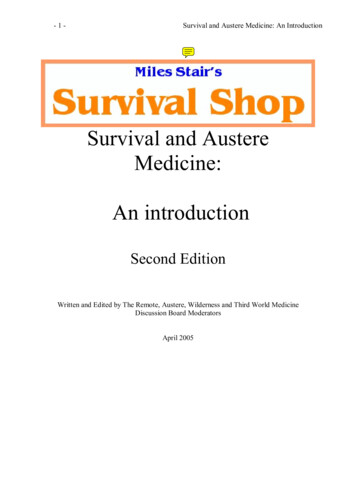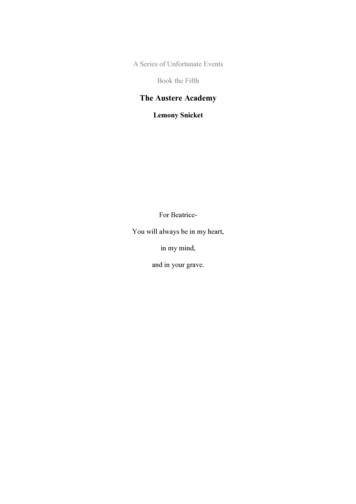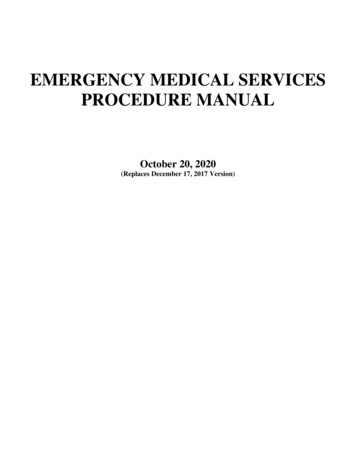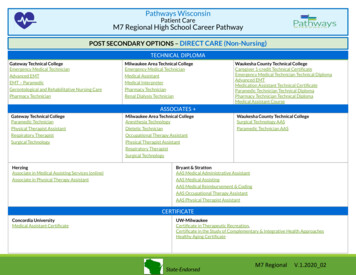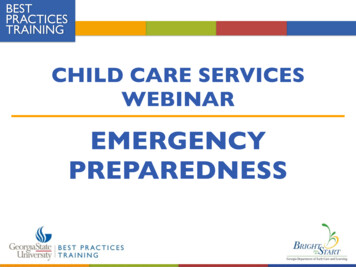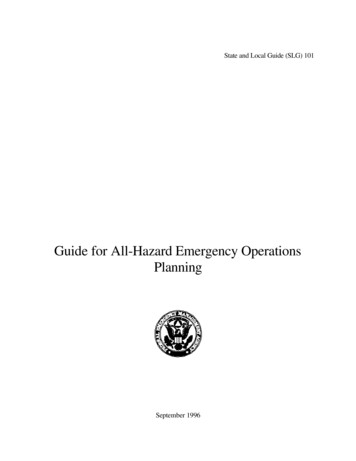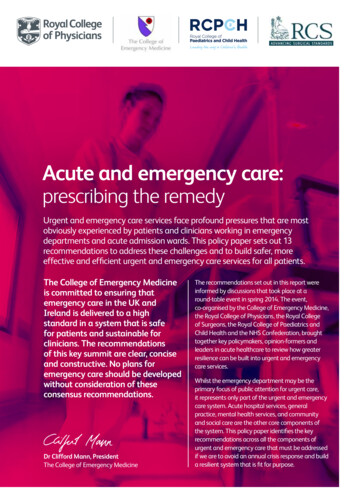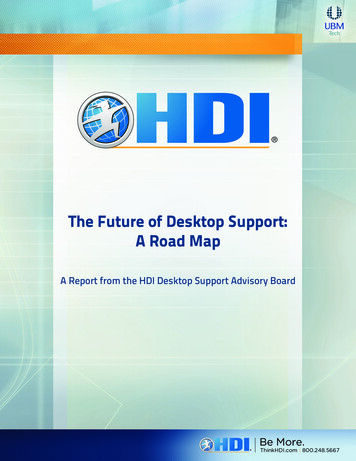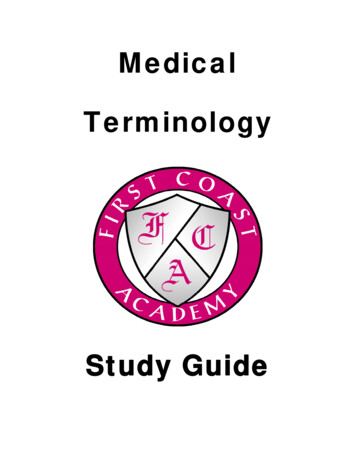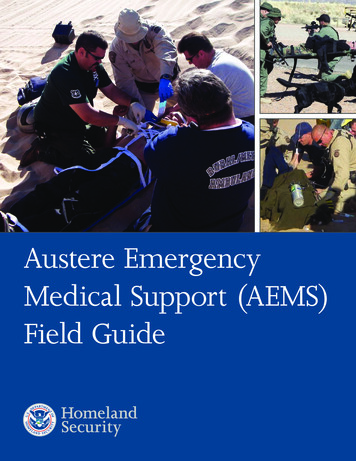
Transcription
Austere EmergencyMedical Support (AEMS)Field Guide
Table of ContentsI.Introduction.1A.B.C.D.E.F.II.General Considerations . 10A.B.C.D.III.Medical Threat Assessment (MTA) . 11Prevention of Infection . 16Mass Casualty Incident Management . 18Medico-Legal Considerations . 21Environmental Protocols . 26A.B.C.D.E.F.G.H.I.J.IV.Foreword . 2Disclaimer. 3Austere Medicine Defined . 4Using This Guide . 5Format of the AEMS Field Guide . 6AEMS Acronyms . 7Altitude-related Disorders . 27Animal-related Injuries: Mammals and Marine Life . 31Cold-related Disorders. 35Dehydration . 39Dive Medicine . 411. General . 412. Drowning . 423. Arterial Gas Emboli (AGE). 454. Decompression Sickness (DCS) . 475. Barotrauma of the Ear . 506. Other Barotraumas . 53Envenomation . 551. Arthropods . 552. Marine Life . 573. Reptiles . 60Heat-related Disorders . 641. Hyperthermia . 642. Other Conditions . 72Vector-borne Illnesses . 75Lightning Injuries . 82Motion Sickness (Sea Sickness) . 85Trauma Protocols . 89A.B.C.D.Advanced Hemostasis. 90Burns . 93Epistaxis . 97Field Dentistry . 1001. General Dental Care . 1002. Alveolar Ridge Fracture .1013. Avulsed Tooth . 1034. Dislocated Tooth . 105i
E.F.G.H.V.Force Health Protection Protocols . V.Fluid Resuscitation . 107Management of Major Trauma . 109Orthopedic Injuries.113Specific Orthopedic Injuries .1171. Facial Fractures .1172. Hand Disorders .1213. Hand Injuries .124Field Sanitation . 129Emergency Medical Evacuation from Operational Sites . 134Occupational Health Considerations .141Sick Call Medicine . 143Acute Abdomen .147Altered Mental Status . 149Cardiac Disorders . 152Deep Vein Thrombosis (DVT) . 154Extended Patient Care . 156Foot Care .162Gastrointestinal Disorders . 166Genitourinary Disorders . 1681. Kidney Stones. 1682. Urinary Tract Infection (UTI) .170Gynecologic Disorders . 172Pregnancy-Related Disorders .174Head, Eyes, Ears, Nose and Throat . 1771. Headache . 1772. Eye Disorders .1783. Ear Infections and Disorders . 1804. Upper Respiratory Infections (Sinusitis and Rhinitis). 183Pulmonary Embolus. 185Respiratory Disorders .187Rhabdomyolysis . 190Skin Disorders . 193Subcutaneous Abscesses . 197Fever without Known Cause . 199Vaccinations . 201Water-related Exposures. 205Procedures .208A. Subcutaneous Abscesses .2101. Incision and Drainage (I&D) .2102. Needle Aspiration.212B. Alternate Wound Closure Techniques .213C. Cervical Spine Clearance .216D. Cricothyroidotomy.218ii
E. Dental Anesthesia . 2201. Apical Infiltration Anesthesia . 2202. Buccal Block . 2223. Inferior Alveolar Nerve Block. 2244. Superior Alveolar Nerve Block (Posterior Superior Alveolar Block) . 226F. Dental Splinting . 2281. Atraumatic Tooth Restoration. 2282. Non-invasive Monofilament Fixation . 230G. Dislocations . 2321. Digit . 2322. Mandible . 2343. Patella . 2364. Shoulder . 238H. Escharotomy . 240I. Intraosseous (IO) Needle . 242J. Local Anesthesia . 2431. Local Infiltrations . 2432. Digital Nerve Block . 2443. Hematoma Block . 2464. Intercostal Nerve Block (Rib Block) . 2485. Posterior Tibial Nerve Block at the Ankle (Plantar Nerve Block) . 250K. Nasal Packing . 2531. Anterior Nasal Packing . 2532. Posterior Nasal Packing . 255L. Needle Thoracostomy . 256M. Orthopedic Splints . 257N. String Trick (Ring Removal) . 263O. Subungual Hematoma . 265P. Urethral Catheterization . 266Q. Wound Care . 2691. Wound Prep and Irrigation . 2692. Laceration Closure . 2713. Simple Loop Suture . 2754. Vertical Mattress Suture . 2775. Instrument Tie . 2796. Two-handed Field Tie. 281R. Suturing Tubes and IV Lines in Place. 282VII.Appendices . 283Appendix A.Appendix B.Appendix C.Appendix D.Appendix E.Pain Management . 284Glasgow Coma Scale. 285Mini-Mental Status Exam . 286IV Drip Chart . 287Formulary . 288iii
I.IntroductionA. ForewordB. DisclaimerC. Austere Medicine DefinedD. Using This GuideE.Format of the AEMS Field GuideF.AEMS AcronymsDHS AUSTERE EMERGENCY MEDICAL SUPPORT FIELD GUIDEI INTRODUCTION1
A. ForewordThe following protocols outline the emergency medical support that can be administered under austere conditionsby emergency medical services (EMS) providers credentialed by the Department of Homeland Security (DHS)Office of Health Affairs (OHA). These protocols are intended to supplement the DHS/OHA Basic Life Support(BLS) and Advanced Life Support (ALS) protocols when providers are operating in austere environments.The protocols guide the management of individual patients while considering the circumstances underwhich patient evaluation and treatment may occur. Any given patient may require the use of a single protocol,a portion of a protocol, or a combination of several protocols. OHA expects that providers will use the protocolsto assess, and to establish a treatment plan for each patient.For DHS-agency EMS programs to implement these protocols, they will need both approval by the ProgramMedical Director and approved training and skills testing. As such, some specific components of the protocolsmay be unavailable to most DHS providers. The Program Medical Director must also approve a provider’s scopeof practice, including medication and equipment requirements, which are defined by training, competencies,and operational capabilities.Much of the guidance in these protocols will be of greater use to other providers responsible for medical supportto DHS operations under austere conditions.EMS providers operating under remote, austere, or hostile conditions are expected to provide pre-hospitalcare in these dangerous environments with little or no support when operational security is a consideration.In some situations, communications are not assured and evacuation may be delayed significantly.Three factors drive AEMS:1. Mission2. Overall Team Healtha. Self-Careb. Buddy Carec. Team Care3. Protection of:a. Team Membersb. Victims/Hostagesc. Bystandersd. PerpetratorsCare providers in an austere situation may be forced to improvise and adapt their medical procedures based onextant circumstances to provide care for and prepare the patient for evacuation to a safer environment. This guide,in conjunction with standard EMT/paramedic protocols, is intended to improve the DHS providers’ capability toprovide the best possible pre-hospital care until the patient can be transferred for definitive medical treatment.2I INTRODUCTIONDHS AUSTERE EMERGENCY MEDICAL SUPPORT FIELD GUIDE
B. DisclaimerThe AEMS field guide is intended to serve as a series of suggested best practices. Medical providers are stronglyencouraged to follow these suggestions, and should consider doing so in whole or in part to the extent thathis/her training or experience is sufficient.DHS AUSTERE EMERGENCY MEDICAL SUPPORT FIELD GUIDEI INTRODUCTION3
C. Austere Medicine Defined“Austere EMS” is the delivery of EMS care under conditions of limited personnel and equipment resources,and outside the existing framework of normal EMS. An austere EMS environment may include elements ofany of the following:1. An ongoing physical environmental threat (e.g., heat, cold, water, wind, or altitude)2. Limited medical supplies, technologies, or resources3. Limited medical expertise available4. Limited communications, including little or no access to medical direction or oversight5. Limited availability of transportation6. Altered condition of the medical responder7. Urgent clinical situation requiring immediate intervention outside of standard protocols8. Duration of care extended beyond standard operational situations9. Any other factor or condition that alters the ability of the EMS responder to provide necessaryemergency medical care10. Limited capacity to provide care due to security environment4I INTRODUCTIONDHS AUSTERE EMERGENCY MEDICAL SUPPORT FIELD GUIDE
D. Using This GuideThis guide, in conjunction with standard EMT/paramedic protocols, is intended to guide medical supportand pre-hospital emergency care that may be required in austere environments. It should be considered asituation-based adjustment to a provider’s normal scope of EMS practice, and may be followed—in whole orin part—when routine protocols are impossible or insufficient. The EMS provider on scene must consider theoverall austere scenario, previous training, experience, medical direction, and the acuity of the clinical situationto determine when to deviate from routine EMS protocols and follow these guidelines. These guidelines assumethat patients will be transferred to the appropriate level of medical care as expeditiously as possible.Certification and Training Levels of ProviderThe medical care and procedures described in this field guide are divided into several levels of provider training,including Basic Life Support (BLS) and Advanced Life Support (ALS). Many of the protocols require completionof a minimum of a Wilderness upgrade to the basic certifications, since they are not taught as part of routine BLSor ALS training curricula. Medical directors are responsible for ensuring that the protocols implemented by theirservices match the training and competencies of their providers.Much of the material described under Force Health Protection requires medical training beyond BLS and ALScurricula. These skills may best be implemented by more advanced providers, or by EMS personnel followingcompletion of an 80-hour Sick Call Screeners Course.DHS AUSTERE EMERGENCY MEDICAL SUPPORT FIELD GUIDEI INTRODUCTION5
E. Format of the AEMS Field GuideThe AEMS guide is divided into the following sections: General Considerations (e.g., body substance isolation, medico-legal consideration)Environmental Protocols (e.g., altitude related disorders, heat related conditions)Trauma Protocols (e.g., advanced hemostasis, burns, orthopedic injuries)Force Health Protection Protocols (e.g., evaluation and care of team members who develop medical conditionsduring the mission) Procedures (e.g., cricothyroidotomy, nasal packing, wound care) Appendices (e.g., antibiotic therapy, pain management, charts and tables)The Environmental Protocols, Trauma Protocols, and Force Health Protection Protocols use the following format: Review of Injury/Illness; may include Risk Factors (optional) Anatomy and Physiology (optional) Signs and Symptoms Management BLS ALS Evacuation Considerations Extended Care; may include Management of Complications (optional) Follow-up (optional) Other/Special Considerations (optional) Preventive Measures (optional)6I INTRODUCTIONDHS AUSTERE EMERGENCY MEDICAL SUPPORT FIELD GUIDE
F. AEMS AcronymsA&PAnatomy & PhysiologyCPRCardio Pulmonary ResuscitationABCAirway, Breathing, CirculationCSFCerebrospinal FluidABDAbdominalCVATCostoVertebral Angle TendernessABXAntibioticsD5LRDextrose 5% Lactated Ringer’sACDAllergic Contact DermatitisD5NSDextrose 5% Normal SalineACSAcute Coronary SyndromeDAEDysbaric Air EmbolismAEDAutomatic External DefibrillatordBDecibelAEMSAustere Emergency Medical SupportDCSDecompression SicknessAEROVAC Aeromedical EvacuationDICDisseminated Intravascular CoagulationAGEArterial Gas EmbolismDIPDistal Interphalangeal JointAHAAmerican Heart AssociationDNRDo Not ResuscitateALSAdvanced Life SupportDOEDyspnea on ExertionAMSAltered Mental StatusDPDistal PhalanxAMIAcute Mountain IllnessDTRDeep Tendon ReflexesASAAspirinDVTDeep Vein ThrombosisASAPAs Soon As PossibleEACExternal Auditory CanalAUBAbnormal Uterine BleedingEDCExtensor Digitorium CommunicAVAtrioventricularEOMExtraocular MotionBIDTwice DailyEOMIExtraocular Motion IntactBLSBasic Life SupportETEndotrachealBMBowel MovementETTEndotracheal TubeBPBlood PressureFBForeign BodybpmBeats per MinutefswFeet Sea WaterBSABody Surface AreaGIGastrointestinalBSIBody Substance IsolationGICGlass Ionomer CementBVMBag Valve MaskGUGenitourinaryCASEVAC Casualty EvacuationgttsDropsCFCylinder Factor ConstantHAHeadacheCHFCongestive Heart FailureHACEHigh Altitude Cerebral EdemaCKCreative KinaseHAPEHigh Altitude Pulmonary EdemaCNSCentral Nervous SystemHAZMAT Hazardous MaterialsCOCarbon MonoxideHEPAHigh-efficiency Particulate AirCO2Carbon DioxideHNFHead, Neck and FaceCONUSContinental United StatesHRHeart RateDHS AUSTERE EMERGENCY MEDICAL SUPPORT FIELD GUIDEI INTRODUCTION7
8HTSHypertonic Saline (3%)NPNasopharyngeal AirwayHxHistoryNPONothing per Oral (Orally)I&DIncision & DrainageNRBMNon-rebreathing MaskI&OIntake & OutputNSNormal SalineICIncident CommandNSAIDNon-steroidal Anti-Inflammatory DrugICDIrritant Contact DermatitisN/VNausea/VomitingICNBIntercostal Nerve BlockIEBInner Ear BarotraumaOCONUS Outside the Continental United States(Overseas)IOIntraosseousOPOropharyngeal AirwayIMIntramuscularOPSECOperational SecurityIVIntravenousOTCOver the CounterIVFIntravenous FluidPASGPneumatic Anti-shock GarmentIVPIntravenous PushPBTPulmonary BarotraumaJVDJugular Venous DistensionPEPulmonary EmboluskgKilogramPHFPotentially Hazardous FoodKVOKeep Vein OpenPIPProximal Interphalangeal JointLOCLevel of ConsciousnessPMIPoint of Maximum IntensitylpmLiters per MinutePMSPulse, Motor, SensoryLRLactated Ringer’sppPartial PressureLSILife Saving InterventionPPEPersonal Protective EquipmentLUQLeft Upper QuadrantPPMParts Per MillionLZLanding ZonePRPer RectumMCIMass Casualty IncidentPRNAs NeededMCPMetocarpal Phalangeal JointPSIPounds per Square InchMDIMetered Dose InhalerPVTPulseless Ventricular TachycardiaMEBMiddle Ear BarotraumaPOBy MouthMEDEVAC Aeromedical Evacuationq6hEvery Six HoursmgMilligramQDEvery Day (Daily)mlMilliliterQHSEvery BedtimeMSMental StatusQIDFour Times DailyMSEMental Status ExamqtQuartMTAMedical Threat AssessmentR/ORule OutNa SodiumRIGRabies Immune GlobulinNCNasal CannulaROMRange of MotionNGNasogastricrpResidual PressureI INTRODUCTIONDHS AUSTERE EMERGENCY MEDICAL SUPPORT FIELD GUIDE
rpmRespirations per MinuteRRRespiratory RateSALTSort, Assess, Life Saving Intervention,Treatment and/or TransportSBOSmall Bowel ObstructionSBPSystolic Blood PressureSNaSerum Na SPFSun Protection FactorS/SSigns and/or SymptomsSLSublingualSPO2Oxygen SaturationSQSubcutaneousSTDSexually Transmitted DiseaseTBSATotal Body Surface AreaTBTuberculosisTBITraumatic Brain InjuryTCCCTactical Combat Casualty CareTdTetanus-DiptheriaTIDThree Times DailyTiGTetanus Immune GlobulintpTank PressureTMTympanic MembraneTMJTemporal Mandibular JointUCLUlnar Collateral LigamentURIUpper Respiratory InfectionUSARUrban Search and RescueUTIUrinary Tract InfectionUTMUniversal Transverse MercatorUVUltra VioletVFVentricular FibrillationVSVital SignsWNVWest Nile VirusDHS AUSTERE EMERGENCY MEDICAL SUPPORT FIELD GUIDEI INTRODUCTION9
II. General ConsiderationsA. Medical Threat AssessmentB. Prevention of InfectionC. Mass Casualty Incident ManagementD. Medico-Legal Considerations10II GENERAL CONSIDERATIONSDHS AUSTERE EMERGENCY MEDICAL SUPPORT FIELD GUIDE
A. Medical Threat Assessment (MTA)Overview1. The medical threat assessment (MTA) is a detailed report, written before the mission, which analyzes themedical aspects and impacts of a tactical operation.2. Preparation of the MTA is vital to mission-planning and operational risk-management.a. MTA should be performed well in advance of the proposed operation, if possibleb. Data gathering for the MTA must be conducted in a manner that insures operationalsecurity (OPSEC)3. Tactical EMS personnel are responsible for providing the mission commander and/or team with abriefing based on the MTA for law-enforcement missions.4. The MTA should be mission- and site-specific.5. Many agencies use a standard form for MTA.Elements of the Medical Threat Assessment1. Type of operation and operational objectives.2. Name of MTA preparer, assigned tactical or other EMS provider(s), and back-up EMS provider(s)3. Locationa. Descriptiveb. Mapc. Aerial photographsd. Longitude/latitude, Universal Transverse Mercator (UTM) grid coordinatese. Local day/night visibility Time of sunrise and sunset Time of moonrise and moonsetf. Local roads and traffic patternsg. Type of terrain (e.g., urban, industrial, forested, scrub, density, mountainous)4. Weather conditionsa. Based on climactic data, long- and short-range forecasts and direct observation Climactic data and long-range forecasts are used to plan advanced missions and extended operations Short-range forecasts and direct observation are used immediately before and during the operationb. Data should include: Ambient temperature Humidity Wet bulb
8. Duration of care extended beyond standard operational situations 9. Any other factor or condition that alters the ability of the EMS responder to provide necessary emergency medical care 10. Limited capacity to provide
